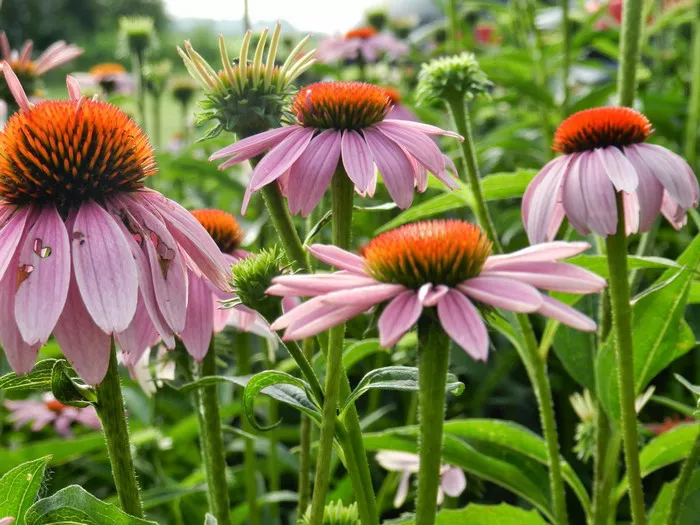Coneflowers, also known as Echinacea, are renowned for their resilience, vibrant blooms, and ability to attract pollinators. Gardeners and nature enthusiasts alike are drawn to these beautiful perennials for their long-lasting display of color and their role in supporting biodiversity. However, many individuals may wonder: How long do coneflowers actually bloom? In this article, we delve into the intricacies of coneflower bloom cycles, exploring factors that influence their flowering duration and offering practical tips for maximizing their presence in your garden.
Understanding Coneflower Bloom Cycles
Before diving into the specifics of how long coneflowers bloom, it’s essential to understand the typical life cycle of these perennial plants. Coneflowers are characterized by their daisy-like appearance, with prominent, cone-shaped centers surrounded by colorful petals. They belong to the Asteraceae family and are native to North America.
The bloom cycle of coneflowers can be divided into several distinct stages:
1. Emergence: In early spring, coneflower plants begin to emerge from the soil. As temperatures rise and daylight hours increase, the dormant plants awaken and send up new growth. This initial stage sets the foundation for the upcoming blooming period.
2. Vegetative Growth: Once emerged, coneflowers focus on vegetative growth, developing sturdy stems, lush foliage, and robust root systems. During this phase, the plants gather nutrients and energy to support flowering later in the season.
3. Budding: As summer approaches, coneflowers begin to form flower buds at the tips of their stems. These buds gradually swell and mature, preparing to burst into full bloom.
4. Flowering: The peak of the coneflower’s beauty arrives during the flowering stage. Each bud opens to reveal a striking composite flower, attracting bees, butterflies, and other pollinators. Depending on the variety, coneflowers can bloom for several weeks or even months.
5. Seed Formation: After the flowers have been pollinated, they undergo seed formation. The vibrant petals gradually fade, and the cone-shaped centers develop seeds. This stage marks the end of the blooming period but sets the stage for future generations of coneflowers.
6. Dormancy: As the growing season comes to a close, coneflowers enter a period of dormancy. Above-ground growth may wither and die back, while the plant’s energy is redirected to the roots for winter survival. Despite appearing dormant, coneflowers are still alive beneath the surface, awaiting the return of favorable conditions.
Factors Influencing Coneflower Bloom Duration
The duration of coneflower blooms can vary significantly depending on several factors. Understanding these influences can help gardeners manage their plants more effectively and prolong the flowering period:
1. Variety: Different coneflower varieties exhibit varying bloom durations. Some cultivars may bloom for several weeks, while others may continue flowering for months on end. When selecting coneflowers for your garden, consider the expected bloom time of each variety to ensure a prolonged display of color.
2. Environmental Conditions: Environmental factors such as temperature, sunlight, and moisture play a crucial role in coneflower bloom duration. Adequate sunlight is essential for robust flowering, so plant coneflowers in a location that receives at least six hours of direct sunlight per day. Additionally, consistent moisture levels, provided through regular watering, promote healthy growth and prolonged blooming.
3. Soil Quality: The quality of the soil can impact the overall health and vigor of coneflowers, thereby influencing their bloom duration. Coneflowers prefer well-draining soil with a slightly acidic to neutral pH. Amending the soil with organic matter, such as compost or aged manure, can improve soil structure and fertility, supporting extended blooming periods.
4. Deadheading: Deadheading, or the removal of spent flowers, can encourage coneflowers to continue blooming throughout the season. By preventing the formation of seeds, deadheading redirects the plant’s energy back into flower production. Simply snip off faded blooms as they wither, using clean garden shears or scissors.
5. Fertilization: Proper fertilization can promote healthy growth and prolonged blooming in coneflowers. Use a balanced fertilizer formulated for flowering perennials, applying it according to package instructions. Avoid over-fertilizing, as excessive nitrogen can stimulate lush foliage at the expense of flowers.
6. Pest and Disease Management: Pests and diseases can hinder coneflower growth and diminish bloom duration. Keep an eye out for common pests such as aphids, spider mites, and powdery mildew, addressing any infestations promptly. Implementing cultural practices such as proper spacing and adequate air circulation can help prevent disease outbreaks.
By addressing these factors, gardeners can optimize growing conditions for coneflowers and extend their blooming period for maximum enjoyment.
How Long Do Coneflowers Typically Bloom?
Now that we’ve explored the various factors influencing coneflower bloom duration, let’s address the question at hand: How long do coneflowers actually bloom?
In general, coneflowers are known for their extended bloom period, typically lasting from early summer through the first frost of fall. Depending on the variety and growing conditions, individual flowers may remain in bloom for one to two weeks before fading and being replaced by new blooms.
Certain cultivars, such as Echinacea purpurea ‘Magnus’ and Echinacea purpurea ‘White Swan,’ are renowned for their long-lasting flowers and may continue blooming for several months under optimal conditions. Additionally, newer introductions and hybrid varieties may offer extended bloom periods and a wider range of colors, further enhancing the garden’s visual appeal.
To prolong the blooming period of coneflowers, gardeners can employ the strategies outlined earlier, including deadheading, proper fertilization, and pest management. By providing favorable growing conditions and attentive care, it’s possible to enjoy a continuous display of coneflower blooms throughout the growing season.
Conclusion
While individual bloom duration may vary depending on factors such as variety, environmental conditions, and cultural practices, coneflowers typically bloom from early summer to the first frost of fall. By selecting suitable varieties, providing optimal growing conditions, and implementing proper care techniques, gardeners can extend the blooming period and create a stunning floral display that lasts for months on end.


